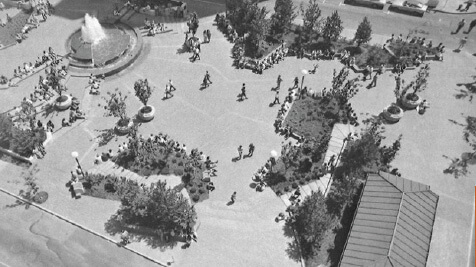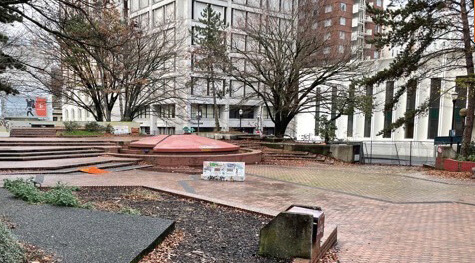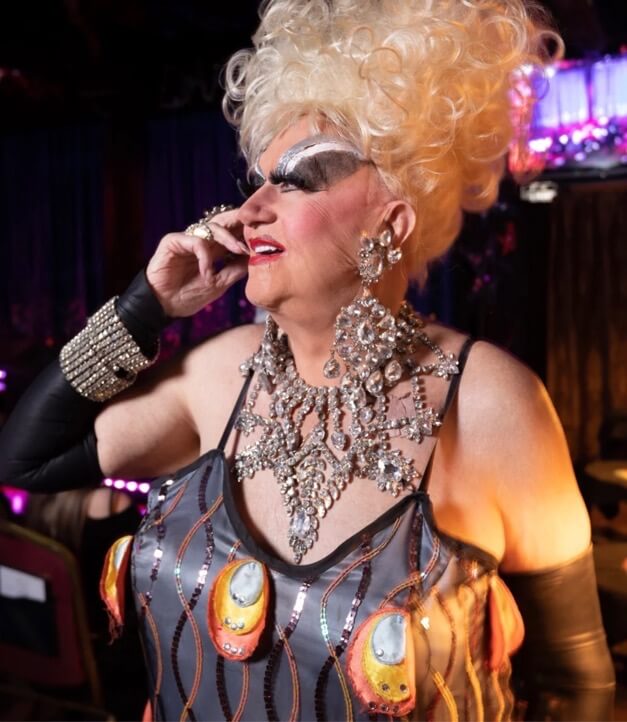Built in the 1970s to be a lively fountain plaza topping a subgrade garage, O’Bryant Square gradually turned into Portland’s most challenged public space. Early on, the membrane failed, leaking water into the garage and forcing the fountain to be shut off. As the landscape grew, so did hiding places and subcultures, drawing skateboarders, downtown youth, and revelers from the “Pink Triangle,” a collection of nearby gay bars with a vibrant night life. However, with no adjacent housing, a cluster of social service agencies took root nearby, and people-less “telco hotels”–where telecommunications businesses lease space for their computer equipment–sprouted on three sides.

In the 2010s, the plaza exploded in daytime life when the city’s first food cart pod grew to more than 50 vendors on the adjacent block. But the food carts were eventually displaced by a construction project: a new high rise combo of offices, condos, and a Ritz Carlton Hotel.
On the opposite corner, Multnomah County opened its first Behavioral Mental Health Center. The facility offered much needed treatment and shelter. But it often overflowed with more people than it could serve and drew more dealers, addicts, and mentally ill to the area. Finally, in 2018, owing to structural failures with the garage beneath, the city closed and fenced in the square.
Soon after the closure, the pandemic drained away nearby office workers and the manifold crises of houselessness, mental illness, and fentanyl overtook the city. O’Bryant became downtown Portland’s most blighted area. As the economic and social extremes unfolded, the square needed a new life. But Portland Parks and Recreation–PP&R–had insufficient funding and will to build a fully realized replacement.

As all this was happening, I was the executive director of the Portland Parks Foundation—PPF–and we were determined to reverse the park’s downward trajectory. PPF successfully lobbied the city to demolish the Square at a cost of $4.5 million and build a simple, inexpensive “interim park.” The budget for that was anticipated to be $1.5 million.
I brought the challenge of what next to the Loeb Fellowship Collaboratory, an annual alumni event at which Fellows volunteer ideas and specific actions to support community benefit projects. A number of alums pledged participation for a community design charrette, and I put together a powerhouse team. A generous Loeb Alumni Grant of $5,000 funded the travel and expenses for 5 Fellows to participate in 5-day charrette.
The Loeb Team was :
- Christopher Calott ’11, Berkeley, CA; Robert and Millicent Lalanne Chair of Real Estate Development at UC Berkeley
- Susan Chin ’99, New York, NY; design consultant and former director of Design Trust for Public Spaces
- Roger Cummings ’09, Minneapolis, MN; chief culture producer and cofounder of Juxtaposition Arts
- Damon Rich ’07, Newark, NJ; designer, urban planner, and partner at Hector
- Jennifer Siegal ’03, Los Angeles, CA; founder of the Office of Mobile Design.
Additionally, Ed McNamara ’95 would facilitate a key session with property owners; Charles McKinney ’94 joined the charrette; and Kevin Cavenaugh ’08, Stephen Goldsmith ’00, and Eli Spevak ’14 participated in panels and workshops.
The prospect of Loeb expertise encouraged PP&R to embrace the interim park idea and to collaborate with Portland State University’s Center for Public Interest Design¬–well known for its tactical urbanist projects–as design lead. Those resources and monies leveraged an additional $150,000 in grants, sponsorships, and in-kind donations from government, foundations and firms focused on public interest, and neighboring property owners.
The result was Back to Square One: Reimagining O’Bryant Square (ROS for short). The name is a reference to Park Block One, the site’s label in Portland’s earliest plat map, and the hope for a fresh start.
 During March and April, 2023, ROS meaningfully engaged more than 1,000 Portlanders to offer ideas about how O’Bryant Square could be a harbinger of positive change. PPF gained generous media coverage that augmented robust social media outreach and attracted widespread interest. Six webinars, attended by over 650 viewers, paired the Loeb Fellows with local counterparts in the fields of community design, social services, mental health, urban youth, real estate, and pop-up architecture. A public survey garnered some 400 responses, and two community open houses offered further opportunities for idea generation and feedback. Additionally, we convened eight discussions with key stakeholders representing arts and culture; property owners; downtown youth; retail and hospitality; service providers; safety, management, and maintenance personnel; Behavioral Health Resource Center clients; and downtown residents.
During March and April, 2023, ROS meaningfully engaged more than 1,000 Portlanders to offer ideas about how O’Bryant Square could be a harbinger of positive change. PPF gained generous media coverage that augmented robust social media outreach and attracted widespread interest. Six webinars, attended by over 650 viewers, paired the Loeb Fellows with local counterparts in the fields of community design, social services, mental health, urban youth, real estate, and pop-up architecture. A public survey garnered some 400 responses, and two community open houses offered further opportunities for idea generation and feedback. Additionally, we convened eight discussions with key stakeholders representing arts and culture; property owners; downtown youth; retail and hospitality; service providers; safety, management, and maintenance personnel; Behavioral Health Resource Center clients; and downtown residents.
